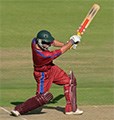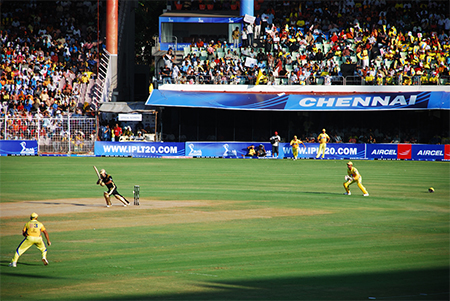Indian Premier League signals new era in world cricket

04.05.2008
By Michael HerbornThe Indian Premier League, cricket’s new, all-action, TV-friendly tournament, is reshaping cricket. While cricket has been shaped by television more than most other sports, Twenty20, a new form of the game designed with television and stadium audiences in mind, looks set to determine the future of the game.
 |
|
Indian Premier League match between Chennai Super Kings and Kolkata Knight Riders. Photo (c) Ravages and uploaded under a Creative Commons licence. |
From international Test matches to English county games, cricket is being affected by a cash injection from India, cricket’s economic powerhouse.
In a reversal of the usual south to north migration route that exists within most professions, many of the world’s finest cricketers are heading to India to take part in the six-week long Indian Premier League (IPL), developed by the Board of Cricket Control in India (BCCI), the game’s governing body in India.
Realising the significance of this development, other cricket boards are examining the possibility of staging Twenty20 tournaments of their own. The English and Wales Cricket Board (ECB) is rumoured to be in talks with Allen Stanford, the American billionaire owner of the Stanford 20/20 cricket tournament played in the Caribbean, and Lalit Modi, head of the IPL, to establish an English version of the tournament. The Pakistan Cricket Board (PCB) is also looking into proposals for a similar venture in 2009.
| Fan-friendly Twenty20 Twenty20, a relatively new form of cricket pared down to the bare essentials of batting and bowling, was invented by the England and Wales Cricket Board (ECB). The ECB wanted an event that could bring people back to cricket stadiums; something short enough to attract the after-work audience and exciting enough to draw in new audiences to cricket. The ploy worked, with the ECB’s Twenty20 cup bringing in over half a million supporters into stadiums both 2005 and 2006 according to figures released by the ECB, up from around 200,000 in 2003 when the league was first established. In India, early viewing figures suggest that the IPL is having an even greater impact. Sportsbuisness.com reports that more than twice as many people tuned in for the tournament than had been expected with 12.5 million viewers watching the opening match in Bangalore (read more here). Audience analysts IMRB, say the broadcast earned 8.21 Television Rating Points in India, as opposed to the 4 - 6 Television Ratings Points earned by the national cricket team’s recent tour of Australia.
|
Twenty20 has the potential to turn cricket from a sport where the focus has traditionally been upon nations, to a sport focussed upon clubs and star players.
Big money cricket
India generates around 70% of world cricket’s income, according to figures quoted by the BBC. It is the financial heart of international cricket.
Since its inception in late 2007, the IPL has already generated USD 900 million for the BCCI through the sale of television rights reports the Reuters news agency.
Indian cricket’s wealth means that some of the top stars in the IPL, such as Andrew Symonds, Sachin Tendulkar and Mahendra Singh Dhoni will earn over USD 1 million for a period of six weeks. And this figure looks set to rise even further in the future, says Lalit Modi, chairman of the newly-founded league.
“We set a salary cap of USD 5 million per team [in salaries] for the first season. We didn't want a couple of extremely rich individuals to create a situation where it's only a few teams, like Manchester United or Chelsea, who can win the title,” Modi told British newspaper, The Telegraph referring to the entrenched position of the top four in English football.
“But if we hadn't done that, I can tell you that our players would already be the highest-paid across any sport in the world,” he continued. “It will happen - if not today, then tomorrow. Because once the franchises have established themselves, it will be a free-for-all.”
Rival league
Money is not the only benefit of hosting the IPL for the BCCI. The BCCI no longer holds a monopoly upon Indian cricket, after the emergence of the Indian Cricket League (ICL), a privately run Twenty20 venture.
The ICL is backed by media mogul Subash Chandra, the head of television network Zee Telefilms. It receives no support from the BCCI, and its emergence constitutes a direct threat to the traditional monopoly enjoyed by the cricket board in India.
The ICL has been able to draw a television audience similar level to that of a recent international between India and Pakistan, reports cricket website, Indian Cricket League News. Like the IPL, the league features a mixture of foreign and domestic talent, though with fewer of the big names that are associated with the IPL.
But for the ICL to be globally successful, it needs the top stars, and this is where the IPL and BCCI hold the trump cards.
The BCCI was able to convince other cricket boards across the world not to recognise the rebel league when it launched. The economic value of maintaining good relations with the BCCI, meant that other national cricket boards and the International Cricket Council quickly fell in line.
In return for their support, the BCCI agreed that players would only be allowed to join the IPL if they received clearance from their national cricket board. The agreement also means that players who sign up for the ICL risk being barred from playing for their national teams, effectively ending their careers outside of the rebel league.
This is no mere threat. Shane Bond, perhaps New Zealand’s most talented bowler, has been frozen out of international test match cricket after his decision to sign for the ICL.
English exodus?
The impact of this deal, could prove most problematic for motherland of cricket, England.
Currently, English international cricketers are precluded from the tournament and its high wages due to a clash with English national team fixtures. The IPL also clashes with the start of the English domestic season.
That means for an England national team cricket player to join the IPL, they must effectively end their international career. For non-national team players, they must forgo the start of the domestic season. Either way, as things stand, when English players choose the IPL, English cricket loses out.
Nonetheless, several English internationals have expressed interest in joining the IPL, including the England captain, Michael Vaughan, reports London’s The Times.
“We're naive if we think that England players aren't going to end up playing in the IPL,” Vaughan told The Times. “When you're talking such a huge amount of money in such a short space of time, players are going to be interested and they're going to play in it. Somewhere down the line, I'm sure a schedule will be put in place that makes players available.”
One national team fringe player, Dimitri Mascarenhas, has in fact joined the IPL after striking a deal with his domestic team that will allow him to play for the last two weeks of the IPL this season, and for a full season in the two following years.
Restraint of trade
Finding a way to accommodate the needs of the England players and the needs of English cricket will be a key challenge for the ECB.
Many cricketers may feel that even if some accommodation is made for the IPL, due to the limits on the number of foreign players allowed in the league and the quality of the ones already playing in it, joining the ICL is a more attractive option.
For a talented player who can see no real future role with the national team, the choice between for the local county team and a more lucrative contract with the rebel ICL, the threat of a national team ban carries little weight. An anonymous survey conducted by the English Professional Cricketers' Association of 344 current players, revealed that 35% of players who have represented England would consider retiring prematurely if it meant reaping the rewards of Twenty20 cricket in India, reports the Guardian.
Another cricketer on the fringes of the England team, Vikram Solanki, was due to join the ICL though withdraw over concerns for his international career.
“Sport in general is a short career for most people and you must take opportunities to maximise your earning potential,” says Solanki, reports cricket website cricinfo.com.
“It's unreasonable to place sanctions, restrictions, rules without giving good reason. I'm baffled by the reasoning offered sometimes for some of the sanctions and us as a group of players and the PCA should demand some clarity on the matter definitely. I'm no expert on legal matters but it seems like restraint of trade.”
The decision to prevent English players from joining the ICL is even more controversial given that there will be twenty players from the ICL on show in the English County Championship, including New Zealander Bond.
New leagues
The way out then could be the creation of new leagues, where domestic fixtures and international matches can be scheduled without clashes. Such a system could provide a means for talented players to honour their domestic commitments while also giving the top players the chance to earn top salaries.
Both the English and Pakistani cricket boards have suggested the establishment of future Twenty20 tournaments.
The ECB look set to establish a league with the assistance of Allen Stanford, the owner of the Stanford 20/20 tournament based in the Caribbean, which will commence in 2010, perhaps in the form of a winner takes all tournament between an England and West Indies team, reports the Guardian.
The PCB also looks set to stage a competition in 2009, along similar lines to the IPL: “From next year, we will offer franchise of teams like in the IPL to interested companies and individuals and work has already begun in this direction,” an official from the PCB told the Press Trust of India.
Whether either of these tournaments will be a success in unclear; there is a certain danger that the market for Twenty20 cricket could be saturated by too many tournaments with not enough players to make each one competitive. What is certain though is that Twenty20 has changed the cricket world for the foreseeable future; the cricket calendar used to be based on international competitions, now it looks set to revolve around clubs.
See also:
- Indian Premier League
- But what if Stanford could see beyond the shoot-out?, The Guardian
- ECB face challenge to ICL player bans, The Daily Telegraph
- If it works, Indian league will transform cricket, The International Herald Tribune
- IPL heralds dawn of cricket's fourth epoch, The Daily Telegraph
- IPL founder warns England stars, BBC Sport
- How will the IPL change cricket, BBC Sport
- 'This is proper cricket, without the boring bits', The Guardian
- IPL windfall? Taxman knocks on BCCI's door, The Indian Express
- IPL nurtures cultural understanding: Ponting, ABC Online






